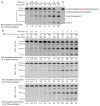14-3-3 adaptor proteins recruit AID to 5'-AGCT-3'-rich switch regions for class switch recombination
- PMID: 20729863
- PMCID: PMC3645988
- DOI: 10.1038/nsmb.1884
14-3-3 adaptor proteins recruit AID to 5'-AGCT-3'-rich switch regions for class switch recombination
Abstract
Class switch DNA recombination (CSR) is the mechanism that diversifies the biological effector functions of antibodies. Activation-induced cytidine deaminase (AID), a key protein in CSR, targets immunoglobulin H (IgH) switch regions, which contain 5'-AGCT-3' repeats in their core. How AID is recruited to switch regions remains unclear. Here we show that 14-3-3 adaptor proteins have an important role in CSR. 14-3-3 proteins specifically bound 5'-AGCT-3' repeats, were upregulated in B cells undergoing CSR and were recruited with AID to the switch regions that are involved in CSR events (Smu-->Sgamma1, Smu-->Sgamma3 or Smu-->Salpha). Moreover, blocking 14-3-3 by difopein, 14-3-3gamma deficiency or expression of a dominant-negative 14-3-3sigma mutant impaired recruitment of AID to switch regions and decreased CSR. Finally, 14-3-3 proteins interacted directly with AID and enhanced AID-mediated in vitro DNA deamination, further emphasizing the important role of these adaptors in CSR.
Conflict of interest statement
Figures









Similar articles
-
Regulation of immunoglobulin class-switch recombination: choreography of noncoding transcription, targeted DNA deamination, and long-range DNA repair.Adv Immunol. 2014;122:1-57. doi: 10.1016/B978-0-12-800267-4.00001-8. Adv Immunol. 2014. PMID: 24507154 Free PMC article. Review.
-
Scaffold functions of 14-3-3 adaptors in B cell immunoglobulin class switch DNA recombination.PLoS One. 2013 Nov 25;8(11):e80414. doi: 10.1371/journal.pone.0080414. eCollection 2013. PLoS One. 2013. PMID: 24282540 Free PMC article.
-
Induction of activation-induced cytidine deaminase-targeting adaptor 14-3-3γ is mediated by NF-κB-dependent recruitment of CFP1 to the 5'-CpG-3'-rich 14-3-3γ promoter and is sustained by E2A.J Immunol. 2013 Aug 15;191(4):1895-906. doi: 10.4049/jimmunol.1300922. Epub 2013 Jul 12. J Immunol. 2013. PMID: 23851690 Free PMC article.
-
Overlapping activation-induced cytidine deaminase hotspot motifs in Ig class-switch recombination.Proc Natl Acad Sci U S A. 2011 Jul 12;108(28):11584-9. doi: 10.1073/pnas.1018726108. Epub 2011 Jun 27. Proc Natl Acad Sci U S A. 2011. PMID: 21709240 Free PMC article.
-
Regulation of aicda expression and AID activity: relevance to somatic hypermutation and class switch DNA recombination.Crit Rev Immunol. 2007;27(4):367-97. doi: 10.1615/critrevimmunol.v27.i4.60. Crit Rev Immunol. 2007. PMID: 18197815 Free PMC article. Review.
Cited by
-
Distinct Requirements of CHD4 during B Cell Development and Antibody Response.Cell Rep. 2019 Apr 30;27(5):1472-1486.e5. doi: 10.1016/j.celrep.2019.04.011. Cell Rep. 2019. PMID: 31042474 Free PMC article.
-
Regulation of immunoglobulin class-switch recombination: choreography of noncoding transcription, targeted DNA deamination, and long-range DNA repair.Adv Immunol. 2014;122:1-57. doi: 10.1016/B978-0-12-800267-4.00001-8. Adv Immunol. 2014. PMID: 24507154 Free PMC article. Review.
-
AID targeting is dependent on RNA polymerase II pausing.Semin Immunol. 2012 Aug;24(4):281-6. doi: 10.1016/j.smim.2012.06.001. Epub 2012 Jul 10. Semin Immunol. 2012. PMID: 22784681 Free PMC article. Review.
-
Estrogen Reverses HDAC Inhibitor-Mediated Repression of Aicda and Class-Switching in Antibody and Autoantibody Responses by Downregulation of miR-26a.Front Immunol. 2020 Mar 24;11:491. doi: 10.3389/fimmu.2020.00491. eCollection 2020. Front Immunol. 2020. PMID: 32265934 Free PMC article.
-
AID Recognizes Structured DNA for Class Switch Recombination.Mol Cell. 2017 Aug 3;67(3):361-373.e4. doi: 10.1016/j.molcel.2017.06.034. Epub 2017 Jul 27. Mol Cell. 2017. PMID: 28757211 Free PMC article.
References
-
- Maizels N. Immunoglobulin gene diversification. Annu Rev Genet. 2005;39:23–46. - PubMed
-
- Casali P. Somatic recombination and hypermutation in the immune system. In: Krebs JE, Goldstein ES, Kilpatrick ST, editors. Lewin's Genes X. Jones & Bartlett; Sudbury, MA: 2011. pp. 570–623.
-
- Odegard VH, Schatz DG. Targeting of somatic hypermutation. Nat Rev Immunol. 2006;6:573–583. - PubMed
-
- Teng G, Papavasiliou FN. Immunoglobulin somatic hypermutation. Annu Rev Genet. 2007;41:107–120. - PubMed
Publication types
MeSH terms
Substances
Grants and funding
- P41 GM103533/GM/NIGMS NIH HHS/United States
- R01 AR040908/AR/NIAMS NIH HHS/United States
- R56 AI045011/AI/NIAID NIH HHS/United States
- P01 CA116676/CA/NCI NIH HHS/United States
- AI 079705/AI/NIAID NIH HHS/United States
- AI 045011/AI/NIAID NIH HHS/United States
- T32 AI060573/AI/NIAID NIH HHS/United States
- R01 AI079705/AI/NIAID NIH HHS/United States
- T32 CA009054/CA/NCI NIH HHS/United States
- R56 AI079705/AI/NIAID NIH HHS/United States
- AI 060573/AI/NIAID NIH HHS/United States
- P41 RR011823/RR/NCRR NIH HHS/United States
- P01 CA 116676/CA/NCI NIH HHS/United States
- R01 AI045011/AI/NIAID NIH HHS/United States
LinkOut - more resources
Full Text Sources
Molecular Biology Databases

